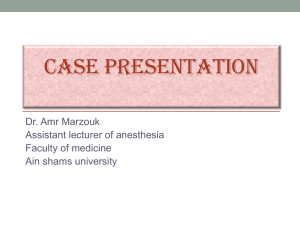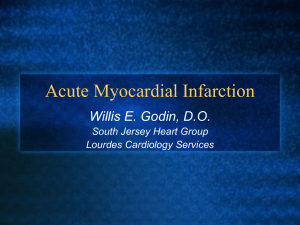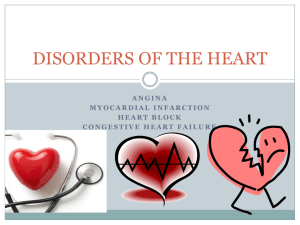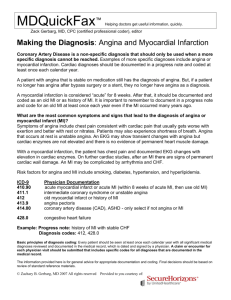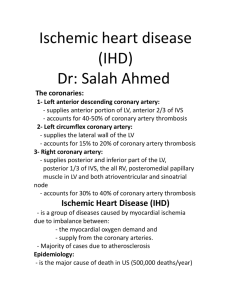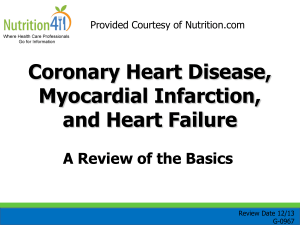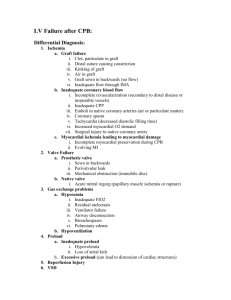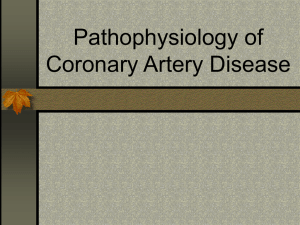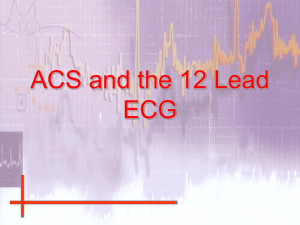ACS
advertisement
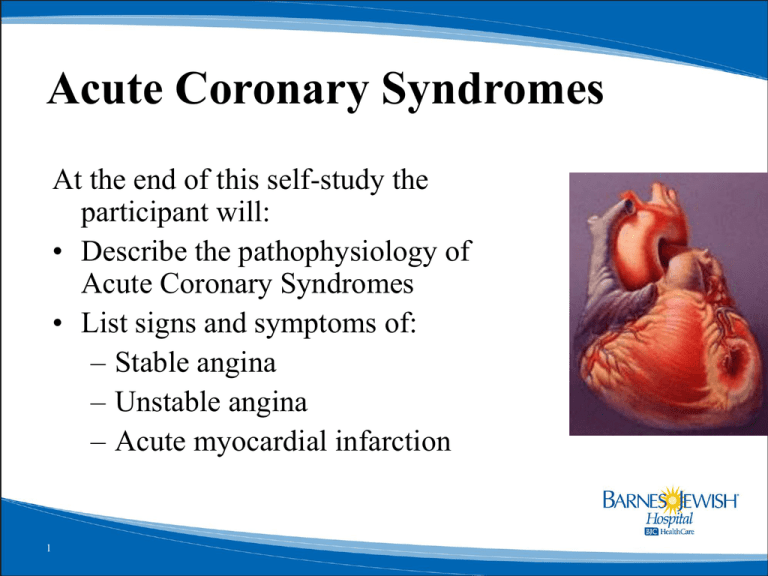
Acute Coronary Syndromes At the end of this self-study the participant will: • Describe the pathophysiology of Acute Coronary Syndromes • List signs and symptoms of: – Stable angina – Unstable angina – Acute myocardial infarction 1 What is ACS? • The term Acute Coronary Syndrome (ACS) includes a constellation of syndromes: chest pain, unstable angina, non ST elevation MI (Non-STEMI) and ST elevation MI (STEMI). • The American College of Cardiology (ACC) and American Heart Association (AHA) recommends that health care providers use the term ACS as a provisional diagnosis and once the diagnosis is made use the term that applies: Chest Pain Syndrome, Unstable Angina, Non-Q wave MI and Q-wave MI. • Mortality rates and the risk associated with ACS is the greatest during the first 30 days after presentation and stabilizes to a lower rate after 30 days, validating the importance of early diagnosis and treatment.1 2 ACS: Triad of I’s Ischemia vs. Injury vs. Infarction All represent an oxygen supply problem: • Ischemia = reversible • Injury = acute period of both ischemia and infarction • Infarction = irreversible cell death 3 ACS • Unstable angina (U/A) – a clinical syndrome usually resulting from disrupted atherosclerotic plaque, which subsequently results in an imbalance between myocardial oxygen supply and demand. – U/A and Non-STEMI are closely related in presentation. – ECG may show ST depression, • or be normal – Cardiac enzymes are normal – Ischemia is reversible 4 ACS • Non-ST Elevation Myocardial Infarction (Non-STEMI) – Differs from unstable angina mostly due to severity of ischemia – Non-STEMI causes enough myocardial damage to release detectable cardiac markers indicating myocardial injury [Troponin I (TnI), Troponin T (TnT), and/ or Creatinine kinase( CK-MB)].1 – ECG changes may occur • No sustained ST segment elevation. – Can limit the area of infarction through medical and nursing interventions 5 ACS • ST Elevation Myocardial Infarction (STEMI) – a loss of cardiac myocytes as a result of prolonged ischemia due to a perfusion-dependent imbalance between supply and demand. – Myocardial ischemia does not cause immediate cell death but rather it occurs over a finite period of time. It can take at least 4 to 6 hours for complete necrosis of myocardial cells – This is dependent upon the presence of collateral blood flow into the ischemic zone or coronary artery occlusion.2 6 Examples of ST changes in STEMI ECG changes that commonly occur with increasing levels of coronary artery occlusion 7 Signs and Symptoms Overview • Only 30-40% of all MI’s present with typical S & S’s. • 60-70% exhibits less typical symptoms: – Women exhibit less obvious symptoms than men – If over age 75, syncope is the main symptom – Diabetics express very non-specific symptoms – What if you are a diabetic female over the age of 75? • Cardiac risk factors must play an important role in deciding who receives a 12-lead ECG and who does not. 8 Cardiac Risk Factors 9 Factors That Can’t Be Changed Factors that can be changed or controlled Heredity Gender Age Smoking Hypertension Hypercholsterolemia Obesity Physical Inactivity Stress Diabetes History of Presenting Illness • The most important diagnostic information is the patient’s “story” – – – – 10 Current symptoms Time of onset Pain assessment Past medical history / medications “Typical” Signs and Symptoms of MI • Chest discomfort: – Crushing, pressure, tightness – Sustained – Unrelieved or partially relieved by rest – Unrelieved or partially relieved by nitroglycerin – Pain may radiate to other areas 11 Associated Signs and Symptoms of MI • Denial • • • • • • Chest discomfort Syncope/weakness Cool/pale/diaphoretic Dyspnea Nausea/vomiting Sense of impending doom PQRST: Eliciting pain information • P: Placement/ provocation/ precipitating factors • Q: Quality • R: Radiation, relief and reproducibility • S: Severity (0-10 scale) • T: Time of onset 12 Women’s Issues • • • • • • Heart disease leading cause of death Sharp rise in smoking-related illness 1/3 of adult women are sedentary 1 in 3 women are overweight More nonfatal chronic conditions Less available supports – Because many chronic conditions are disabling, middle-aged and older women are about 80% more likely than men to report difficulties in taking care of themselves. U.S. Dept. Health & Human Services, Special Profile Women’s Health, 1996. 13 Cardiac Symptoms in the Elderly • Acute or progressive dyspnea • Extreme fatigue • Abdominal pain • Nausea & vomiting • Syncope • Congestive heart failure • Weakness/falls • Pain in other places (not chest) Nowak, KA. Nurse Pract. 1997. 22:1114. 14 AMI Statistics in the Elderly • Higher in-hospital mortality • Higher post-discharge mortality • Do not have larger infarcts FTT Collaborative Group. Lancet. 1994;343:311. White, HD, et al. Circulation. 1996;94:1826-1833. Miller, TD,et al. Circulation. 1997; 96 (suppl): Abstract 149. Diabetes & Acute MI • Independent predictor of mortality (mechanism unknown) • Lowest mortality in patients who received fibrinolytics • Diabetic patients: – Were older and more often female – Had more anterior MIs and triple vessel CAD – Presented later and were treated later • Left ventricular function may differ from those w/o diabetes due to possible impaired left ventricular performance in non-MI zones 15 Mak, KH, et al. JACC. 1997; 30:171. Woodfield, SL, et al. JACC;1996; 29:35. Strandberg, LE, et al. J Int Med. 2000; 248:119 Mak, KL & Topol, TJ. JACC. 2000; 35: 563-8 Goal: Early Reperfusion Therapy • Reperfusion Therapy – Defined as the initial strategy employed to restore blood flow to the occluded coronary artery by two standards of care • Fibrinolytic therapy • Primary percutaneous transluminal coronary angioplasty (PTCA) • Outcomes Dependent Upon: – Time to treatment – Early and full restoration of blood flow 16 Next: ACS Diagnostics 17



